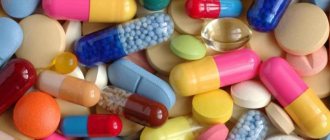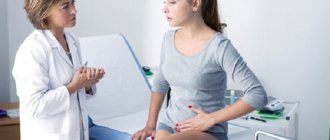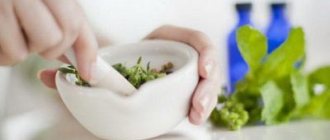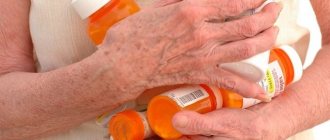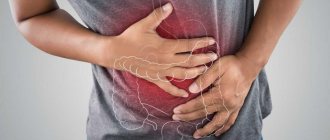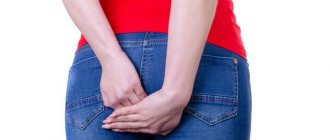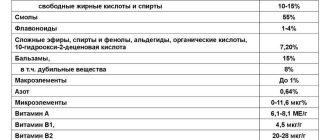The intestines of every person contain a huge number of different microorganisms. Many of them belong to the category of opportunistic pathogens, representing a danger only in the presence of certain factors. Representatives of opportunistic microflora include fungi of the genus Candida, which are the causative agent of such an unpleasant disease as intestinal candidiasis. These microorganisms are quite common; they are present in the body of approximately 80% of the population. However, their presence does not always lead to the development of pathology. This requires various predisposing factors.
Expert opinion
Sevastyanov Roman
General practitioner, hepatologist, gastroenterologist, highest qualification category. Site Expert
Symptoms of the disease depend on the form of its course and the stage of development of the pathological process. Diagnosis includes the use of laboratory research methods and assessment of existing clinical manifestations. Treatment is carried out in 3 areas: elimination of causes, antibacterial therapy, normalization of intestinal microflora.
Characteristics of the pathology
Against the background of prolonged disruption of the immune system or in the presence of other predisposing factors, there is a rapid increase in the number of fungal bacteria of the genus Candida, which are found in the human intestines. These bacteria, or rather, their metabolic products, have a negative effect on the walls of the organ and lead to the development of the inflammatory process. In this case, beneficial bacteria involved in the process of breaking down food die. The intestinal microflora is disrupted, which leads to the appearance of characteristic symptoms of the pathological process.
Intestinal candidiasis is a disease in which the balance of beneficial and opportunistic microflora is disturbed. The number of pathogenic bacteria is constantly growing, and the process of digestion and absorption of nutrients in the intestines is disrupted. The patient develops a pathological condition with all its inherent manifestations.
Risk factors for development
The likelihood of infection increases with casual sexual intercourse, uncontrolled use of antibiotics and drugs that disrupt the natural microflora. Foods with large amounts of sugar and carbohydrates create a favorable environment for fungal growth. Excessive sweating also leads to an exacerbation of candidiasis, so it is necessary to wear cotton underwear that allows the skin to breathe and moisture to evaporate.
At the same time, excessive cleanliness can also cause harm. We are talking about douching. It should not be used as a method of contraception, since it is not effective, and also as a means of hygiene, because it leads to the leaching of the protective flora. If you experience discomfort, you should first consult a doctor.
Signs
The main sign of the development of intestinal candidiasis is a violation of the digestive process. The patient feels discomfort after eating, and pain may occur, and the location of the pain is quite difficult to determine. Appetite is disturbed, the patient feels full even after eating a small amount of food. In addition, there is a persistent bowel disorder. The consistency and color of stool changes, and foreign inclusions can often be seen in the stool.
Intestinal dysfunction negatively affects the condition of the entire digestive tract, and this leads to a deterioration in health, weakness, and discomfort in a person.
The main symptoms include:
- Bloating, which occurs not only after eating food, but also at any other time;
- Heaviness in the epigastric area;
- Painful cramps in the intestines that occur after eating;
- Stool thinning, change in stool consistency;
- Slight increase in body temperature;
- Decreased appetite;
- Bloody and purulent elements in the stool;
- Fetid discharge with a cheesy consistency in the anus;
- Disturbance in the process of defecation (frequent urge, sometimes false, feeling of incomplete bowel movement after visiting the toilet);
- Characteristic rashes on the skin.
Folk remedies against candidiasis
Traditional medicine for the treatment of intestinal thrush suggests a healthy lifestyle.
To maintain the balance of intestinal microflora, it is recommended to eat fresh wild berries: blueberries, blueberries, honeysuckle. Leafy vegetables, greens, cabbage have a beneficial effect on intestinal function.
Eating garlic daily reduces the risk of developing a fungal infection. Horseradish has a depressant effect on the fungus.
Oatmeal jelly has a good effect on the condition of the intestines.
Oatmeal jelly recipe for treating intestinal thrush
Oatmeal is placed in a glass jar (shoulder-deep) and filled to the top with water mixed with kefir and covered with gauze.
The container is placed in a warm place for 3 days. Then the liquid is drained and the sediment is placed in the refrigerator. To brew jelly, take 2-3 tablespoons of sediment, add 0.5 liters of water, bring to a boil and remove. The healing jelly is ready.
For intestinal fungus, take herbal infusions:
- oak bark;
- burnet and calendula;
- yarrow;
- chamomile;
- St. John's wort;
- sage
Before using traditional recipes in practice, you should consult your doctor.
Types and forms
Intestinal candidiasis is usually divided into invasive and non-invasive. Invasive candidiasis has a more severe course. With this form of pathology, the pathogenic bacterium penetrates the tissues of the organ, damaging them. This leads to severe inflammation. Invasive candidiasis can be diffuse (when bacteria damage the healthy walls of an organ along its entire length) and focal (the pathogen invades the walls of the organ in strictly defined places, for example, in areas of ulcers and other physiological damage).
Non-invasive candidiasis is considered a more common and less dangerous type, in which pathogenic microflora actively multiply in the gastrointestinal tract, but do not penetrate its walls. Of course, the waste products of the fungus also have a negative effect on the intestinal walls, however, in this case the inflammatory process is less pronounced.
Symptoms and signs
| Signs of invasive candidiasis | Symptoms of non-invasive candidiasis |
The pathology is more severe and manifests itself in the form of the following symptoms:
| With the non-invasive form of candidiasis, the following manifestations occur:
|
Intestinal candidiasis is a disease prone to rapid development and progression. In the absence of therapy, pathogenic microflora quickly spreads to neighboring areas. The organs of the genitourinary system are most often affected. This situation also has its own symptoms. In particular, the patient experiences copious discharge with a cheesy consistency and a strong, unpleasant odor.
During urination or sexual intercourse (in women), pain and discomfort occurs, and this disease is also characterized by a strong tooth in the area of the penis or vagina. The color of urine changes, it becomes whitish and loses its transparency.
Stages of the disease
There are 3 stages of development of the pathological process.
| Carrier stage | The Candida fungus penetrates the human body, but, with normal functioning of the immune system, its rapid proliferation does not occur. There are no symptoms of the disease and no treatment is required. |
| Breeding stage | When exposed to certain negative factors, an active increase in the number of fungal infections is observed. Bacteria release more waste products that negatively affect the human body, in particular, the performance of the digestive tract. At this stage, the first symptoms appear, such as discomfort and heaviness in the intestines, diarrhea, and loss of appetite. |
| Candidal colitis | The patient's intestines contain a large amount of fungal infection, as a result of which the functioning of the affected organ is significantly impaired. Such manifestations as blood and mucus in the stool and a significant deterioration in health occur. Pathogenic microflora continues to multiply, bacteria also affect other human organs, disrupting their functioning. As a result, the clinical picture becomes more pronounced, symptoms of toxic damage and severe pain of uncertain localization appear. |
Prevention of fungal diseases of the intestines
Fungal diseases are difficult to treat. It is easier to follow preventive measures to prevent intestinal pathology.
It is necessary to treat diseases of the digestive system, follow a diet, avoid long-term use of antibiotics, use purified water for drinking, avoid prolonged exposure to damp areas, avoid synthetic clothing, wear cotton underwear, change your toothbrush monthly, strengthen the immune system by hardening the body and taking vitamins.
Etiology
The main reason for the appearance of candidiasis in the intestines is long-term dysfunction of the immune system. At the same time, there are a number of minor unfavorable factors contributing to the development of this situation. This:
- Belonging to certain age categories (it is known that in young children, as well as in representatives of the older generation, disruptions in the functioning of the immune system are observed much more often);
- Frequent stress, chronic physical or emotional fatigue;
- Pregnancy, childbirth and breastfeeding;
- Congenital or acquired autoimmune diseases;
- The presence of cancerous tumors or the use of potent chemicals to remove them;
- Tendency to allergies;
- Chronic pathologies affecting various parts of the human body;
- Uncontrolled and prolonged use of antimicrobial agents (antibiotics have a detrimental effect not only on pathogenic, but also on beneficial bacteria, leading to their mass death);
- Poor nutrition, in particular, insufficient intake of vitamins and protein products;
- Bad habits, for example, long-term drug use, addiction to alcohol.
Diagnosis of intestinal candidiasis
To identify the presence of candidiasis, the doctor first interviews the patient and evaluates his complaints. After this, additional diagnostic measures are prescribed, including instrumental and laboratory research methods, such as:
- Endoscopy to determine the condition of the mucous membranes of the intestinal walls (with candidiasis, dense white plaque can be seen on these tissues);
- X-ray to detect possible organ damage;
- Microscopic examination of feces and secretions. They contain pathogenic bacteria;
- Bacteriological culture to identify the number of pathogens and determine their sensitivity to the action of a particular antimicrobial drug;
- Histological examination to detect a bacterial agent in intestinal tissue.
Treatment methods
Treatment of intestinal candidiasis is carried out in three different areas:
- Destruction of the pathogenic bacterium;
- Normalization of healthy intestinal microflora and restoration of organ functions;
- Strengthening immunity (treatment of pathological conditions that led to its decrease).
Antibacterial therapy
To suppress the growth of Candida bacteria, special antifungal drugs are used. Most often, topical agents are prescribed, available in the form of rectal suppositories. Such drugs have a faster and more effective effect, because they penetrate directly into the affected area.
Expert opinion
Sevastyanov Roman
General practitioner, hepatologist, gastroenterologist, highest qualification category. Site Expert
In severe cases of the disease, antibacterial treatment is supplemented by the use of systemic antimicrobial agents in the form of tablets for oral use.
Normalization of microflora
To successfully treat candidiasis, it is not enough just to destroy the causative agent of the disease; it is also necessary to stimulate the growth of the number of beneficial microorganisms. For this purpose, various preparations based on pre- and probiotics are used. The action of these remedies helps to increase the number of beneficial bacteria in the intestines, resulting in the restoration of the normal functionality of the organ.
Strengthening the immune system
Since the main cause of the development of candidiasis is considered to be reduced immunity, complex therapy also includes measures to restore the functionality of the immune system. To do this, the patient is prescribed various drugs - immunostimulants, vitamin complexes, and a special diet is developed, which includes a large number of foods rich in vitamins.
How to treat thrush in the intestines
After the doctor gets acquainted with the test results, he draws up a treatment plan, thanks to which the symptoms of the disease will be eliminated and the intestinal microflora will be returned to a healthy life. Treatment consists of three stages:
- The initial goal of therapy is to destroy Candida fungi.
- This is followed by comprehensive treatment. It consists of improving intestinal function, strengthening the immune system, and establishing microbiocenosis.
- The goal of the third stage is proper dietary nutrition.
If fungi multiply very actively, doctors prescribe antifungal medications to patients. Antifungal drugs are prescribed depending on the results of the examinations.
Treatment of non-invasive candidiasis
Therapy consists of taking medications aimed at destroying fungi in the intestinal lumen, which do not have a systemic effect (do not enter the blood). Nystatin, Natamycin, Levorin, and antifungal drugs of the polyene series are popular and effective.
Treatment of invasive candidiasis
Diffuse candidiasis is effectively treated with medications that are absorbed into the general bloodstream. Sometimes doctors prescribe taking antibacterial agents, since they destroy opportunistic representatives living in the intestines. Remember that in parallel with taking antifungal and antibacterial medications, the doctor must prescribe probiotics (useful bacteria)
They normalize intestinal function and make it possible to bring the microflora in order. Improving the functioning of the digestive system is of considerable importance. In this case, the following come to the rescue:
- enzyme preparations;
- medications that promote normal functioning of gastrointestinal motility.
Proper nutrition
The products consumed should not provoke the proliferation of opportunistic microorganisms, that is, prevent their vigorous activity. The patient's body requires a lot of vitamins and microelements, proteins, moderate amounts of carbohydrates and fats, daily consumption of fiber - fresh vegetables and sour fruits. For any type of candidiasis, you should limit products that contain large amounts of simple carbohydrates. So, prohibited foods for thrush include:
- alcoholic and sweet carbonated drinks;
- any flour and yeast products;
- sugar and honey;
- all confectionery products, since they contain a large amount of glucose (for example, cakes, chocolate, pastries, your favorite sweets);
- sweet fruits (plums, grapes);
- potatoes, sugar beets, corn;
- sauces, vinegar;
- dried fruits, blue cheeses.
Drug treatment
To eliminate the causes and symptoms of the pathological process, various groups of medications are used. These are antifungal agents of local or systemic action, agents against dysbacteriosis, vitamin preparations and immunostimulants.
| Name | Description | Reception features | Price |
| Pimafucin | A broad-spectrum drug that negatively affects the activity of fungal microflora. Available in various forms (suppositories, creams, tablets), which allows you to choose the most convenient and effective method of use. | Tablets are taken at 100 mg per day. This amount must be divided by 4 times. Suppositories are used 1-3 times a day, depending on the severity of the problem. Cream for intestinal candidiasis is prescribed quite rarely, only in cases where the infection has spread to the genital area. It also needs to be used 1-3 times a day. The course of treatment is determined individually. | FROM 230 rub. |
| Linex | The drug is available in the form of capsules that are taken orally. The product contains lactobacilli, which have a positive effect on the state of intestinal microflora. The drug actively fights dysbiosis, eliminating its manifestations. | Children are prescribed 1 capsule per day, teenagers can take 1-2 capsules, adults – 2 capsules per day. Duration of treatment is 3-5 days. | From 250 rub. |
| Viferon | The drug in the form of rectal suppositories has an antiviral effect (that is, it fights the causes of disruption of the immune system) and helps strengthen the immune system. | Use 1 candle 2 times a day. Duration of treatment is 5 days, if necessary, therapy can be extended | About 100 rub. |
Therapeutic treatment of dysbiosis and thrush
Thrush and intestinal candidal dysbiosis are respectively treated by a gynecologist/urologist and a gastroenterologist. The treatment regimen is similar and is aimed at:
- Carrying out antifungal therapy - prescribing antifungal drugs of systemic and local action:
- For the treatment of vaginal candidiasis, suppositories, natamycin-based vaginal tablets - "Pimafucin", "Terzhinan" or oral tablets - "Fluconazole" are prescribed.
- Nystatin tablets are more effective for the treatment of intestinal candidiasis.
- At the end of antifungal therapy, the microflora is populated with “beneficial” microorganisms. It is recommended to take probiotics containing bifidobacteria and symbiotic complexes (Bifiform, Acipol, Bifidumbacterin suppositories).
- Immunomodulation is the use of drugs that improve the functioning of the human immune system.
The most effective way to combat dysbiosis is treatment with medications and diet.
The diet limits the consumption of simple carbohydrates and sweet fruits (including watermelon, bananas) and dried fruits, alcohol, and baked goods. At the same time, the number of vegetable dishes in the diet increases, the consumption of lean meats and fish (not fried), as well as natural yoghurts is allowed.
